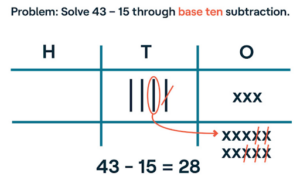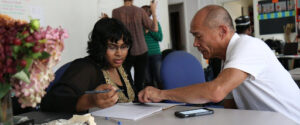10 Math Skills To Master Before Leaving Elementary School

Guest article provided by: By Dominique Padurano, M.S., Ed., Ph.D.
As a private SAT and ACT tutor, I’ve seen teens struggle with math for years. Once, a sixteen-year-old broke out in tears when I asked her, “What’s eight times eight?” However, the pandemic exacerbated most kids’ math challenges. A strong foundation in arithmetic is essential for students who hope to master algebra, geometry, and higher math.
This piece outlines ten skills that every student should acquire by fifth grade, so that they don’t need a private tutor like me in high school!

This is how many of our children are learning subtraction. Image from understood.org, accessed March 18, 2020.
THE “M.D.” FIX: MEMORIZE & DRILL
Here are three things I know: every child can “do” and understand math; their errors and gaps are not their fault; and, finally, you can be your child’s math tutor. We’ve all heard the jokes about “new math”: as Chaucer wrote (albeit in different form), “Many a true word is spoken in jest.” Current pedagogy caused serious flaws in our kids’ mathematical understanding and processing (just check out the photograph above)!
The good news is that the gaps are “fill-able” and the errors are preventable through memorization – which requires repetition, a no-no in the current educational climate, but necessary for mastery. (Even neuroscientist, Stanford Medical School professor, and podcaster Andrew Huberman says so.) I suggest that you quiz your kids verbally on the following facts – and quiz ‘em often. Just because they “learned” 8×7 correctly in third grade doesn’t mean they know it today. And don’t think that if they “learned” it today, that they’ll remember it tomorrow or a week from now. Don’t underestimate the enormous amount of rote memorization that we were required to do as children. Make these quick check-ins regular to ensure mastery.
Start at the top, working your way down the list. Try to “mix it up” (i.e., don’t quiz all the 2’s, then all the 3’s; rather ask “7×9” then “6×8”). When you find that your child is stuck, slow down and do some remediation ( tutor :-)), using the list of resources that follows the list of concepts and skills.
LIST OF ESSENTIAL ARITHMETIC SKILLS (1-5 BEFORE MIDDLE SCHOOL; 6-10 BEFORE HIGH SCHOOL)
- Addition: should be able to add up to any two-digit and one-digit number in their head; bigger numbers on paper
- Subtraction: same as above
- Multiplication: 10×10 table memorized; bigger numbers by hand; know the “perfect squares”
- Division: same as above; should be able to do long division by hand
- Fractions: what are they? be able to reduce, add, subtract, multiply, divide, and convert to / from decimals and percents
- Decimals: what are they? be able to add, subtract, multiply, divide, and convert to / from fractions and percents
- Percents: what are they? be able to convert to / from fractions and decimals; be able to find the percentage of another number (e.g., what’s 16% of 80?)
- Ratio: what is it? what does it tell us?
- Proportion: what is it? how do I set one up?
- Negative numbers: adding, subtracting, multiplying, dividing – even with negative fractions/decimals.
Image by @monicomelty on Unsplash

MAKE MATH PART OF “NORMAL” LIFE
Finally, embed Common Sense / Mathematical Thinking into each of these skills and processes. For example, if I don’t know how to find 16% of 80, but I know that 10% of 80 is 8, I should be able to reason that 16% of 80 is a bit more than 12, because one-half of 8, or the next 5% of 80, is 4, and 8 plus 4 is 12. Especially on multiple-choice tests like the Common Core and (most of) the SAT, using Common Sense / Mathematical Thinking can help students check a right answer and at least eliminate wildly wrong ones.
Make math relevant to daily life. If you’re making a recipe, for instance, show your children how fractions work in real life with halves and thirds of a cup. If you’ve got a fashionista in your house, use percents to show how much they could save on a pair of jeans.
Many students – especially those who have struggled with math in the past – will not engage in mathematical thinking on their own. But when prompted by a parent or tutor to use their common sense to validate (or invalidate) an answer, they can do it. Encourage them to use what they do know to figure out the right answer, even if it’s not the way they’re “supposed” to do a certain problem. This encouragement gives the rule-followers the permission they need to be intellectually flexible enough to reason their way out of a pickle.
LIST OF USEFUL RESOURCES
Everything You Need to Ace MATH in One Big Fat Notebook Less comprehensive than the workbook above, but introduces basic geometry and algebra
Khan Academy Free, online videos and accompanying worksheets
Crimson Coaching Free blog and resources page with helpful articles and tips for parents and students
Math Refresher for Adults Clear and comprehensive workbook
FINAL THOUGHTS
These are scary, trying times. Using just a tiny fraction of your “together time” with your child to shore up their basic arithmetic will pay off not just in their math grades and test scores now, but also in how well their brain can reason and analyze throughout their lives. Now more than ever, we need to mold the next generation to think rationally: our future depends on it.
Wishing you and your families continued good health,
- P.
- What do you think? Post your comments below!
- To read more articles like this, visit the Desk to Nest blog.
- To receive the latest blog post in your inbox, click here.
- To get answers to many questions about education, check out and SUBSCRIBE to my YouTube Channel.
- To get YOUR OWN question answered in my next blog post or YouTube video, email it to me now.
- Until then, see you on Facebook and Instagram!

Graphic by Dominique Padurano. Photos by Jessica Lewis and JESHOOTS on Unsplash.
About the Author

Dominique Padurano, M.S., Ed., Ph.D. – aka “Dr. P.” – loves helping students of all ages fulfill their academic and personal goals. President and Founder of Crimson Coaching, Dr. P. herself personally tutors students in History, English, Spanish, French, Math, and study, time management, and organizational skills; prepares them for tests like the SAT and ACT; and coaches them through the college application process. Essays that students have written under Dr. P.’s guidance have earned them admission to Harvard, Princeton, Stanford, and other top universities, as well as scholarships totaling more than $1million. Also an adjunct professor of U.S. history at the City University of New York and a published author, Dr. P.’s currently writing a memoir of her time as an undergraduate at Harvard. Read more about Dr. P.’s work at www.crimsoncoaching.com and on Google, straight from the hearts and minds of Crimson Coaching’s parents and students.
